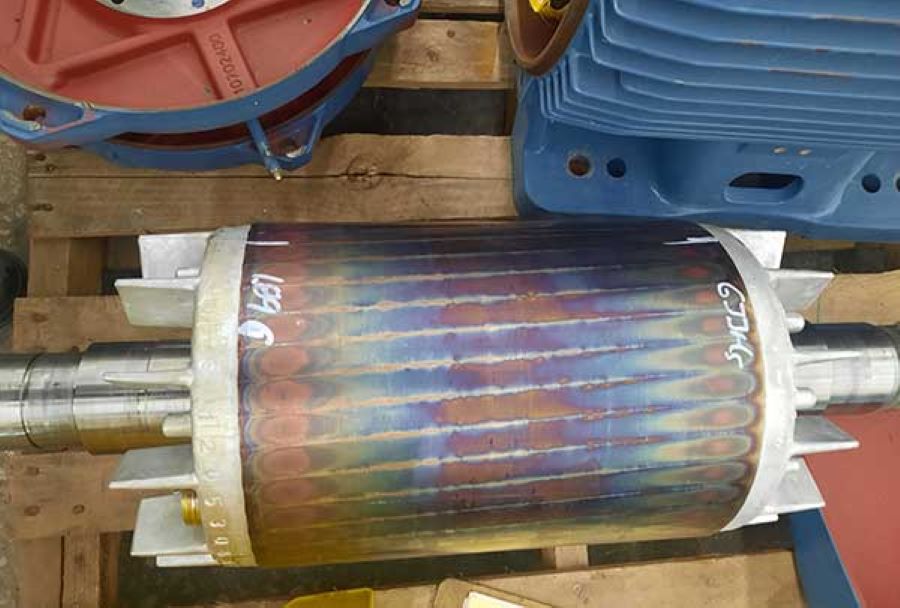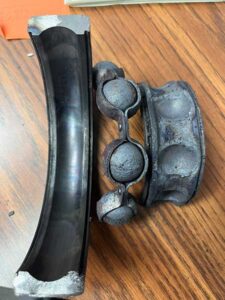Overload And Stall Are Not The Same

An overloaded motor that appears to operate properly is experiencing significant damage.
In the past four years we have experienced an increase in field troubleshooting calls involving catastrophic failures of specific types of equipment. When failed components, from melted bearings to damaged rotors and windings are reviewed and diagnosed as “the motor was overloaded,” the typical initial reaction, even from the equipment package companies, is that the control settings were not correct.
Field testing a number of packaged systems over time has revealed that motors that have service factors that range from 1.0 to 1.2 are regularly loaded from 150% to almost 200%. One comment was that the control settings were fine and the motor would have immediately burned up or stalled if it was overloaded. That is false. Also, responses are typically aimed at non-technical company personnel or those who do not understand motor applications.
The electric motor nameplate is a legal document. The limits and capabilities etched onto this document follow specific standards and deviations from the standards are also included in the nameplate. For instance, if the motor is capable of 1.5 times what is stated on the nameplate, then the service factor would be at least 1.5. If it were on an inverter, that service factor would be identified as possible on a VFD. This value is based upon insulation system design for the machine.
The torque output of a motor, especially a standard motor, follows a torque curve. Most of the motors we’ve observed they have been Design B or equivalent, which has a breakdown torque limit of 200%. The breakdown torque limit is the point where the motor exhibits a drastic change in speed or stalls. While loading close to 200% will not stall the motor, especially if excessive voltage is applied, the current and heat at the motor will be excessive, the rotor will be extremely hot and may discolor, and the shaft will expand, reducing or eliminating the clearances in bearings. Forcing extra air across the motor does not cure this issue as there are other electrical and magnetic field properties that also become problematic.
Standards such as IEEE 117 and IEEE 1776, and IEC 60034-18-31 and IEC 61857 are related to thermal testing to select the insulation rating. UL 1446 is the UL standard for the testing protocol to determine the thermal life curve and rating of these machines. Some value such as 20,000 or 25,000 hours is used to identify the expected life at the rated value, such as Class F, or 155 C.
Motor manufacturers who offer extended warranties will generally use insulation systems at least one class higher than what is needed to protect against improper application, that step is not intended to allow motor overloading. Overloading also blows away any attempts at improving motor efficiency and power factor correction. However, if you load the machine up to a point where you are at 155 C (a properly loaded motor might operate at 120 C), you end up with a machine that effectively has a 2- to 3-yr. insulation thermal life if everything else is perfect.
When checking the setup and loading of your machine, ensure that you are operating within the capabilities of the motor nameplate. This includes service factor, protective device sizing, and thermal class of the motor. If the motor does not identify anything differently on the nameplate, then service factor relates to the motor operating at line frequency and voltage. Just because a motor does not stall at 150% to just under 200% load does not mean it isn’t overloaded.
More information on the proper application of electric motors as jointly developed by manufacturers, owners, repair, government and other stakeholders can be found at the U.S. Department of Energy Motor Challenge web pages.
EP Editorial Staff | April 12, 2024
By Howard W Penrose, PhD, CMRP, CEM, MotorDoc LLC
Howard W. Penrose, PhD, CMRP, is president of MotorDoc LLC, Lombard, IL (motordoc.com). He chairs the wind-power standards and government relations participation for American Clean Power (ACP/AWEA), is the USA representative to CIGRE for high voltage electric machinery, holds various IEEE standards positions, and is a past chair of SMRP. He holds certifications from SMRP as a Certified Maintenance and Reliability Professional and the Association of Energy Engineers (AEE) as a Certified Energy Manager. Reach him at [email protected].
The post "Overload And Stall Are Not The Same" appeared first on Efficient Plant


